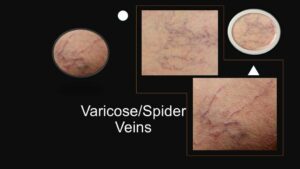
What is Varicose veins and how to treat them
They are swollen, twisted veins that lie just under the skin and usually occur in the legs. Varicose veins are a common condition caused by weak or damaged vein walls and valves. Varicose veins may form whenever blood pressure increases inside your veins. For many people, varicose veins, and spider veins — a common, mild variation of varicose veins — are simply a cosmetic concern. For other people, varicose veins can cause aching pain and discomfort. Sometimes varicose veins lead to more-serious problems.
What are the signs?
Some signs are veins that are dark purple or blue in color, Veins that appear twisted and bulging; they are often like cords on your legs and when painful signs and symptoms occur, they may include:
- An achy or heavy feeling in your legs
- Burning, throbbing, muscle cramping and swelling in your lower legs
- Worsened pain after sitting or standing for a long time.
- Itching around one or more of your veins
- Skin discoloration around a varicose vein
Spider veins are similar to varicose veins, but they’re smaller. Spider veins are found closer to the skin’s surface and are often red or blue. Spider veins occur on the legs, but can also be found on the face. They vary in size and often look like a spider’s web.
How do we get them?
Weak or damaged valves can lead to varicose veins. Arteries carry blood from your heart to the rest of your tissues, and veins return blood from the rest of your body to your heart, so the blood can be recirculated. To return blood to your heart, the veins in your legs must work against gravity. Muscle contractions in your lower legs act as pumps, and elastic vein walls help blood return to your heart. Tiny valves in your veins open as blood flows toward your heart then close to stop blood from flowing backward. If these valves are weak or damaged, blood can flow backward and pool in the vein, causing the veins to stretch or twist.
Are there complications?
Ulcers. Painful ulcers may form on the skin near varicose veins, particularly near the ankles. A discolored spot on the skin usually begins before an ulcer forms.
Blood clots. Occasionally, veins deep within the legs become enlarged. In such cases, the affected leg may become painful and swell. Any persistent leg pain or swelling warrants medical attention because it may indicate a blood clot.
Bleeding. Occasionally, veins very close to the skin may burst. This usually causes only minor bleeding. But any bleeding requires medical attention.
Prevention
There’s no way to completely prevent varicose veins. But improving your circulation and muscle tone may reduce your risk of developing varicose veins or getting additional ones. The same measures you can take to treat the discomfort from varicose veins at home can help prevent varicose veins, including:
- Exercising
- Watching your weight
- Eating a high-fiber, low-salt diet
- Avoiding high heels and tight hosiery
- Elevating your legs
- Changing your sitting or standing position regularly
How do you treat them?
We can either treat them with laser or injection. Book your consultation today>>>

